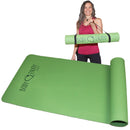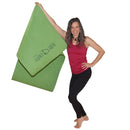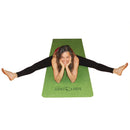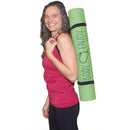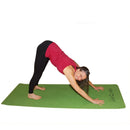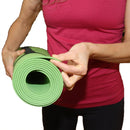Description
Thin Yoga Mat (180x60cm, 4mm thin) including carrying strap - lightweight gym mat for on the go and at home
Thin Yoga Mat (4mm thin):
- ✅ 𝟏𝟎𝟎% 𝐒𝐋𝐈𝐏-𝐑𝐄𝐒𝐈𝐒𝐓 - Water-repellent, washable & slip-resistant: The yoga and fitness training mat is suitable for yoga, Pilates as well as gym fitness and gymnastics exercises
- ✅ FOR ON THE GO - The travel yoga mat is 180x60cm in size and 4mm thin. The non-slip mat is extra lightweight, making it very suitable when you are on the go. A carrying strap is included for free, and the mat rolls up easily
- ✅ 𝟏𝟎𝟎% 𝐇𝐘𝐆𝐈𝐄𝐍𝐈𝐂 - Even if your yoga session is a bit more strenuous, the sports mat can be cleaned quickly and easily: A damp cloth and dish soap are enough to hygienically remove sweat - The mat dries quickly
- ✅ TPE Yoga Mat Our gymnastics mat is made of lightweight and environmentally friendly TPE material. Free from latex, PVC, phthalates, and heavy metals. TPE material is firmer than NBR, wear-resistant, slip-resistant, and can be recycled
- ✅ The thin yoga mat is very suitable in combination and for exercises with the fascial roller .
What is better, a thick or a thin yoga mat?
The choice between a thick or thin yoga mat depends on several factors, including the preferred yoga style, comfort needs, and training location.
Thin yoga mat (1 mm to 4 mm) – More stability & control
Better balance & ground contact:
- The thin yoga mat allows for more stability in standing poses and balance poses.
- Perfect for Vinyasa, Ashtanga, Power Yoga, Fascial Yoga and other dynamic styles.
Light & easy to transport:
- Thinner mats are easier to roll up, fit better in a bag, and are ideal for on the go.
- Thinner yoga mats are significantly lighter than thick mats
- Especially practical for traveling or when you take your mat to the studio.
Direct connection to the ground:
- You can better feel the alignment of the body and perform more precise movements.
- Helps to strengthen the foot muscles and balance.
Less comfort for knees & back:
- Can be uncomfortable on hard floors, especially in kneeling positions or prolonged sitting.
- Less cushioning means higher pressure on sensitive joints.
Little insulation:
- On cold floors, a thin mat can be uncomfortable.
More suitable for:
- Advanced yogis who want more ground contact & stability.
- Dynamic yoga styles (Vinyasa, Power, Ashtanga).
- Frequent travelers or yogis who take their mat to the studio.
- Outdoor yoga on grass or carpeted floors.
Thick yoga mat (5 mm to 12 mm) – Offers more comfort for the joints
Better cushioning & joint protection:
- Ideal for people with sensitive knees, wrists, or back.
- Especially pleasant if you often practice in kneeling or sitting positions (e.g., child's pose, hero's seat).
✔ Perfect for gentle yoga styles:
- Suitable for Yin Yoga, Restorative Yoga, or Hatha Yoga, where you stay longer in individual positions.
- Provides a soft surface for meditation or breathing exercises.
Good for hard floors:
- Especially useful when practicing on tiles, concrete, or thin carpet.
- Prevents pressure points when lying or sitting on the floor for a long time.
Heat insulating:
- A thicker mat protects against cold floors, which is especially pleasant in winter or during outdoor yoga.
Less stability for balance exercises:
- In positions like tree (Vrksasana) or warrior III, a soft mat can be wobbly.
- For dynamic flows, a thick mat can feel too spongy.
Larger & heavier:
- Thick mats are bulkier and heavier to transport.
- They require more space for storage.
Medium-thick yoga mat (4 mm to 6 mm) – The best compromise?
If you are unsure, a mat between 4 mm and 6 mm could be the best middle ground:
✔ Enough cushioning for comfort, but not too soft for balance exercises.
✔ Good for versatile yoga styles – both calm and dynamic sessions.
✔ Still portable, but more comfortable than thin mats.
More fascial yoga products from Body Enjoy
Kunden Rezensionen
Payment & Security
Your payment information is processed securely. We do not store credit card details nor have access to your credit card information.







